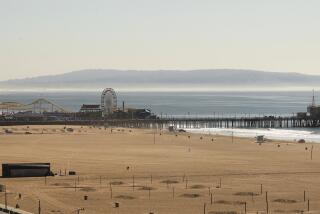Mandate to Clean Santa Monica Bay
- Share via
“Cities Stall Plan to Clean Up Bay” (March 26), regarding the differences between the small cities of L.A. County and some environmental groups, missed the real reason why this storm water permit is controversial.
This permit is an excellent example of the unfunded mandate problem usually associated with Congress or the state Legislature. The county is requiring the small cities to do its “dirty work” without providing the means for those cities to do so.
As a councilman in Redondo Beach and an active participant in the Santa Monica Bay Restoration Project, I am torn between my desire for the bay to be as clean as we can make it, and the realities of the budgetary constraints we live under. If the water board forces the proposed permit down our throats as is, many cities will be out of compliance on day one, with no reasonable possibility that they will ever be able to meet the goals.
It seems to me that the only people who are going to make out in that situation are the lawyers, and that would be an awful waste of resources that could be put into moving us at least partway toward our mutual goal of a cleaner Santa Monica Bay.
BOB PINZLER
Redondo Beach
*
* Three things are crucial to making your next swim in the ocean a healthier one. Don’t swim within three days of a rainstorm. Don’t swim within 300 feet of a flowing storm drain. And, don’t let the cities of Los Angeles County weaken proposed storm water regulations currently before the Regional Water Quality Control Board (RWQCB).
We were pleased to read “Clean It Up, Now” (editorial, March 27). Many cities, Los Angeles among them, support strong anti-pollution regulations. But some cities, including the beach cities El Segundo and Redondo Beach, have refused to come to the table with solid, well-founded solutions to the perceived problems. They think they need expensive scientific studies to determine the sources of storm water pollution.
However, many sources of pollution are simple to identify. If you don’t clean a parking lot, rainfall will carry the debris into the ocean. If a restaurant hoses its food waste in the gutter, it decomposes and creates bacteria that ends up in the surf zone. The proposed L.A.-area storm water permit has provisions that require cities to train their employees in common-sense practices that will reduce these kinds of hazards.
The final arbiters of the permit, the RWQCB members, are appointed by Gov. Pete Wilson. We firmly believe that a “yes” vote for a strong permit will give teeth to the Santa Monica Bay Restoration Plan, the blueprint for cleaning our coastal waters that has been endorsed by Wilson. At stake is a clean ocean--and a $2-billion industry serving coastal tourism and recreation.
MICHAEL CAGGIANO, President
JULIA LOUIS-DREYFUS
Board of Directors
Heal the Bay
Santa Monica
More to Read
Sign up for Essential California
The most important California stories and recommendations in your inbox every morning.
You may occasionally receive promotional content from the Los Angeles Times.













